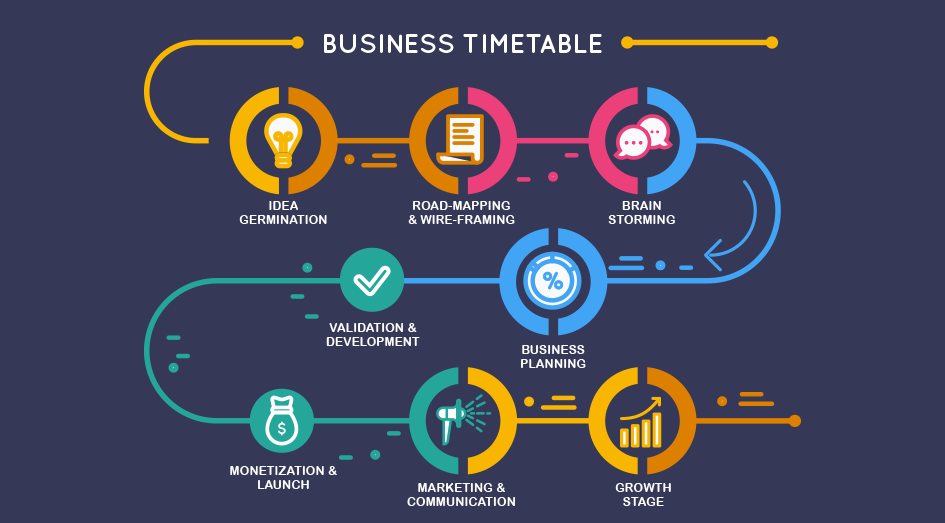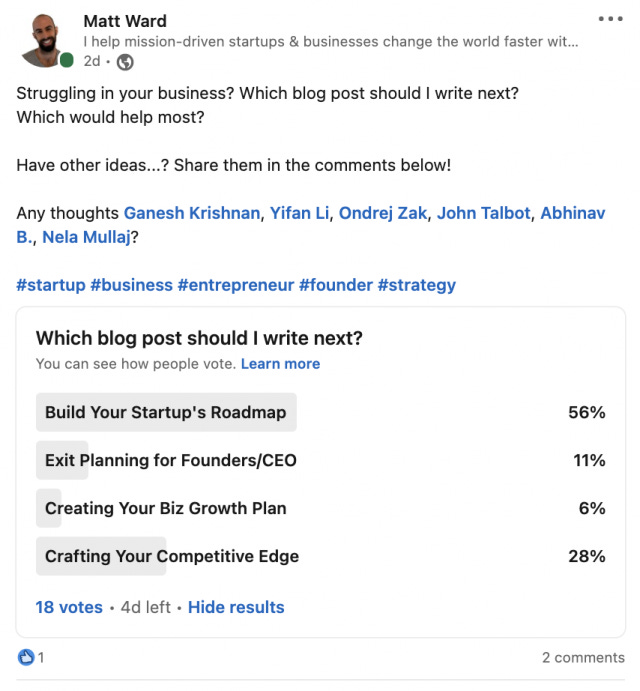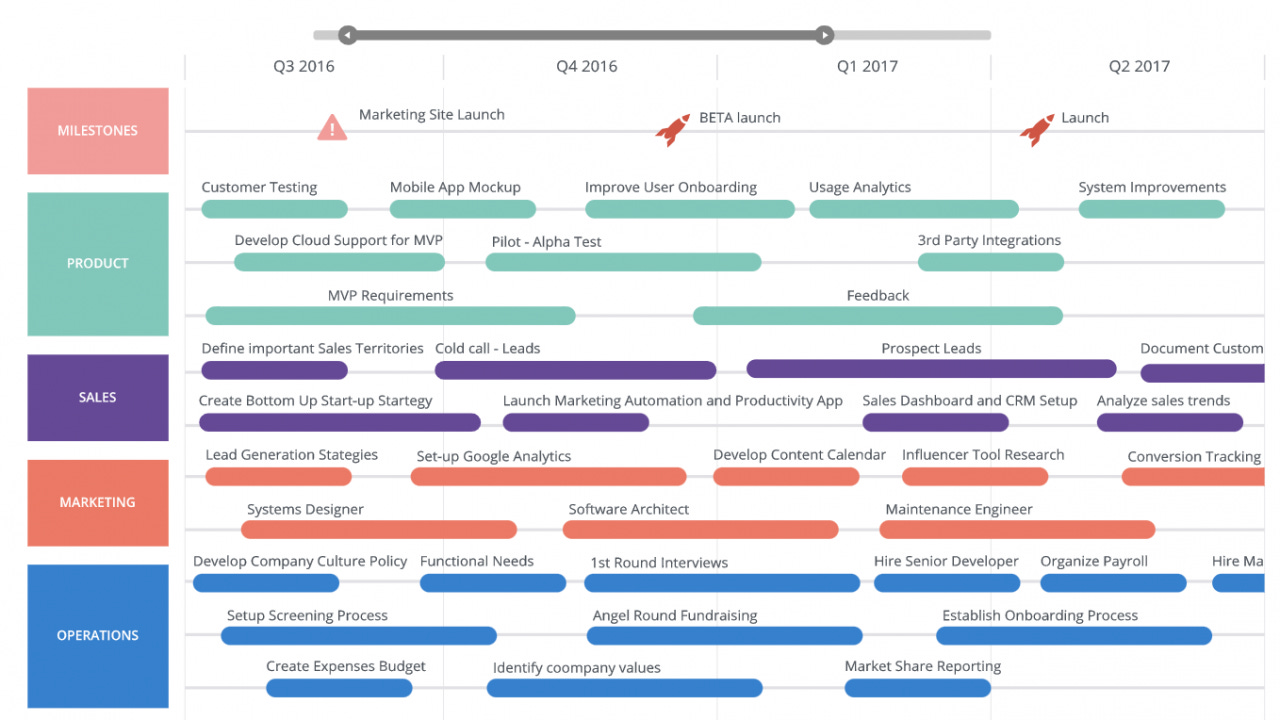How to Build Your Startup's Roadmap: From Idea to IPO and Beyond!
Your Battle Plan to Wow VCs and Win the Market...
Hi there!
Hope you had a great weekend. But now it’s Monday which means it is time to get down to business.
Before we do, a quick announcement: Next Monday Feb 28th @ 6pm CET I’ll be hosting our 1st Remote Demo Days investor pitch session - a chance for top startups to pitch real angels and VCs for funding.
If you’re interested in pitching or attending, be sure to sign up today - space is limited.
Here’s a preview of some of the companies who will be presenting (but we have a few more slots open so don’t delay):
Leva - Digital SPVs to build the venture backbone of Europe.
Potiio - Potable water bottles with soft drink capsules.
Zario - Free yourself from your phone and get on with your life.
Bottleplus - Carbonated sparkling water on the go.
Nebula - The NFT marketplace to "IPO" your music.
It’s going to be a ton of fun so be sure to be there!
But we still have one week to go, so, in the meantime, it’s time to actually get down to business - which often means a business plan, or said a better way (cause your startup might not need a business plan!), a business roadmap - because although you have big hopes and dreams, there huge hurdles to overcome to get there.
Which is where your startup roadmap comes in.
PRO TIP: Your roadmap is a critical part of any startup pitch deck (for more on the perfect pitch deck, see this post) because investors want to know where you’re headed and why you’ll be the next unicorn.
So without further adieu, let’s build that business roadmap…
How to Build Your Startup's Roadmap: From Idea to IPO and Beyond!
If you are reading this, you’re probably a startup founder. And if you’re a founder, you probably have big hopes and dreams - aspirations of what you want your business to be and what you want to create in the world. Whether it is a pure profit play like the next photo sharing app or selling a billion iPhone dongles or something more mission-driven like curing cancer or social media that doesn’t make kids suicidal (hint hint Zuck), there is a long way to go from your rough napkins sketches and early prototypes that define every startup venture to achieving that goal.
The question is: How? How do you get from here to there? And that, my friends, is your business roadmap. It is as simple as that.
So why do so many founders struggle with this topic when putting together their pitch decks and pitching VCs? (BTW if you haven’t checked out the Ultimate Guide to Startup Fundraising, that might help).
It is a bit ironic when you think about it, isn’t it? Shouldn’t it be rather straightforward translating your business goals into actionable steps and milestones?
Unfortunately, it is never that easy. Every startup’s journey is different, there is no one-size-fits-all business roadmap and the road ahead is foggy at best. But still, your startup needs a roadmap. You need to know how you’re going to go from a barebones V1 beta test to becoming the market leader and crushing the competition. And it needs to be detailed enough to avoid getting caught up in the big picture.
Because execution is everything!
And to top it all off, you have to do that all while struggling for funding, trying to fight off the competition and building something incredible the world's probably never seen before.
If it sounds like a nearly impossible challenge, that is because it is. But that is what you signed up for when you founded your company.
That’s where the roadmap comes in.
Because as they say:
“Just put one foot in front of the other and soon you’ll be walking out the door.”
The two roadmaps of your business
Every business walks two tightropes simultaneously: one related to the business and one focused on the product. And unfortunately, the strategy for navigating both couldn’t be more different.
Which is why you need to align your business and product roadmaps with the overall goals of the business well in advance of actually executing on them. Otherwise you'll end up running on a treadmill with one side going faster than the other. Then, you crash and burn.
So, let’s get to work.
The business roadmap
Most startups focus on the business roadmap when planning for the future. Sure they have a list of backlog features to add to the product at some point, but most of the actual planning and forecasting happens on the business and financial side of things. This includes everything from cash flow projections and future fundraising, to user and revenue milestones, new hires, planned market expansions and new sales or marketing initiatives.
Of the two roadmaps, this is clearly more critical. Mess up your burn and cash flow numbers or fail to hit your promised growth targets and there is a good chance your startup (or business) is going to zero before you can raise your next round.
Because only two things can kill a startup: running out of money and co-founder conflict. Everything else can be overcome.
But not that.
So, make sure you spend a good deal of time planning your business’ future. When doing this, consider your goals and the fact that startups typically raise ±18 months of runway to see them through to their next round (for more on why and why you need to plan for 3-6 months to raise your next round, see this post).
In order to think about your goals and split them out into 18 month cycles, it’s important to think about what you’ll need to woo investors. What kind of metrics are comparable companies raising at for seed, Series A, Series B, etc…?
As a rule of thumb, seed investors want founders to have a decent product and some traction (±$10k MRR), while Series A firms look for at least $1M in ARR. Plus don’t forget, with the caliber and quantity of startups these days, many investors expect even more.
And while I’d love to dive deeper into the specifics and tell you exactly what you need to do, unfortunately, every startup and industry is different, making it beyond the scope of this article. That’s your job, so do your research. There are plenty of great resources online.
WORD OF WARNING: Don’t base your assumptions on the outliers. You aren’t the next Clubhouse and just because other founders got billion dollar valuations before shipping a product or making a dime, doesn’t mean you will. In fact, you should plan for the worst case, because the more successful your startup, the less reliant you are on funding (especially valuable if we suddenly enter a bear market). Which equates to resiliency and funnily enough, appeal to investors - kind of like playing hard to get.
Now, once you’ve done all that, once you’ve figured out your milestones and when you need to hit them to avoid going bust, you’re ready to start thinking about HOW. And HOW comes down to execution, it comes down to sales and marketing, to how you’re going to acquire customers/users, where you’ll focus your efforts - which countries/markets, which customer segments, which marketing channels?
Before we go any further, take a moment and answer those questions for yourself. All of these should be included in your comprehensive business roadmap (not necessarily the one you share to investors, but the one you base your business on).
It is going to take some time to get things right and to question and test your assumptions before committing to specific milestones and hurdles. Trust me, the time spent here is anything but wasted. In fact, it’s often worth its weight in gold.
Consider the old adage: “Measure twice, cut once.”
This is especially true in startupland - because with such limited resources, you can’t afford poor planning or major backtracks.
Hence why it’s important to really think about things like when is it time to enter a new market, why focus on Germany before launching in France, why start FB ads before you’ve tried influencer marketing (NOTE: I generally avoid advertising for many reasons (like cost, reliance on FB/Google and the unsustainability of constantly paying for results) and instead, help clients design their ideal organic growth marketing initiatives for sustainable, long-term business growth. Want to learn more? Book your free coaching session today :).
But I’m no crystal ball of business insight here, I’m speaking from personal experience. The biggest mistakes I’ve ever made in business were always failing to plan for success or jumping too quickly into things (more on that here and why I wish I’d had a business coach). Why else would I have started a crowdfunding podcast? It didn’t even matter that Art of the Kickstart grew to be the largest of its kind. Think about it. With just a little foresight and preplanning, I’d have realized, if you’re helping people raise money, they have jack to pay you with… Which is ultimately why I ended up selling the business to a crowdfunding agency later on - because at least they could better monetize it.
PRO TIP: Once you know what your business needs to be successful and what key milestones and action items need to occur, I recommend creating a visual timeline of your business (here’s a great overview of some free tools you can use). And a picture here’s worth a million business plans in terms of getting an overview and perspective on your business. And like a captain charting murky waters, the last thing you can do as the founder or CEO is lose sight of your destination.
The product roadmap
But the business side of things is only half the battle because:
Unless your product or service really wows customers, you’re basically toilet paper - a boring, replaceable commodity whose margins, like the company itself, eventually get flushed down the toilet.
This is the 21st century. We have access to essentially everything so the best product and user experience almost always win out. That makes your product roadmap the lifeblood of your company.
If that sounds like a lot of pressure, that’s because it is. But you’re in a startup after all, you signed up for this.
Instead of worrying about perfection, your product roadmap is meant to encompass the strategic direction of your business and user experience. It’s not about making the prettiest product or coding the smartest AI, it’s about delivering results.
And that means focusing on the wants and needs of customers. It means better functionality, new features, faster updates and improvements, perhaps even new product lines. But that all depends on your industry and use cases - i.e. it's complicated.
That’s why with so many options, it all comes down to prioritization. What should you do first and why? Are you better off adding an Android version, offering one-click checkout or decreasing load time? Would customers prefer a Linkedin integration or the ability to collaborate within teams? Should you launch a remake of a classic product or create something new entirely?
All of these are questions you need to be asking yourself and your customers. And while your customers often give you great insights, it’s important not to be fooled by false desires.
Remember the old adage:
The customer isn’t ALWAYS right.
Henry Ford once famously said, ““If I had asked people what they wanted, they would have said faster horses.” And Steve Jobs said something similar about the iPhone.
When it comes to true disruptive innovation, it often pays to follow your gut. Because imagination requires inspiration, i.e., past experiences.
All that said, in most cases, customers can tell you exactly what they want. Just ask them. Seriously, ask them!
Poll your customers on social media or in Slack, send an email questionnaire, try a couple cold calls or customer interviews… you’ll be astonished what you can learn by just talking to customers.
And the icing on the cake: they’ll love and appreciate that you took the time to ask and feel like partial owners of the end result - all of which bodes well for sales and engagement :)
Merging the business and product roadmaps
As we said earlier, the key to a good business roadmap is aligning both product and business goals and objectives. It means not trying to launch 10 new features while simultaneously entering Europe and adding multi-language support; it means having funding secured for the new developers you need to hire; it means doubling down on troubleshooting and customer onboarding once you’ve found product market fit (PMF), as opposed to pushing new deployments.
Basically, everything needs to be in sync, like a well-oiled machine.
And if Tesla and electric vehicles have taught us anything, it’s that the fewer moving parts and engine (or an organization) have, the easier it is to steer, the faster it can go and the longer it lasts - all of which sound pretty good when considering the future of your business.
So, take your two business roadmaps and slap them together. See how things fit. Do you have major growth or fundraising phases lining up with serious dev work and new releases? Will you have the funds and runway to hire new salespeople to bolster Q3’s Asia rollout? Can you hit those Series A growth metrics without needing to raise a bridge round?
Awesome, you’re ALMOST there.
But what happens if there’s a hiccup in your system? Because there is also a hiccup, shit ALWAYS hits the fan.
If your startup roadmap doesn’t have a little wiggle room to handle the unexpected or isn’t resilient enough to recover from a weak Q4 or a DDoS attack on your server, your startup’s doomed from the start.
So plan ahead, but plan for your plans to be shattered. Be ambitious, plan for success, but remember, it’s just a roadmap and you’re at the wheel…
There’s no “self-driving” here!
So, set your destination, check your maps’ GPS, grab the wheel, floor it and don’t be afraid to act if you see signs for a shortcut or detour.
Remember, this is your race to lose.
Good luck!
Strategy and Growth Hacks Newsletter BONUSES (just for subscribing):
How to Build a Series A Fundable Startup: The 15 Step Guide to Acquiring & Retaining Customers
The 9 Ways to Engineer Viral Products and Word of Mouth Marketing
How to Craft a Killer Pitch Deck VCs Can't Ignore
The 13 Biggest Mistakes Startups Make While Fundraising
Add your email, get the guides, never miss a thing. Start scaling faster!
PS. If you need help with your fundraising strategy, pitch deck, pitch/practice or with growing and scaling your company faster, I’d love to help.




